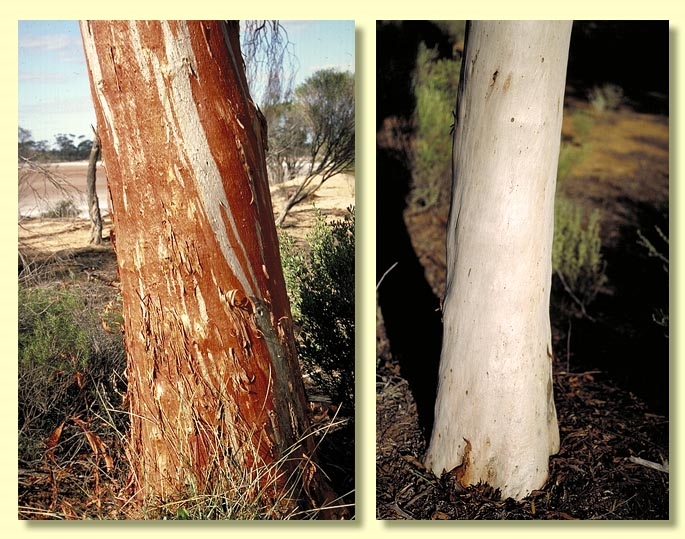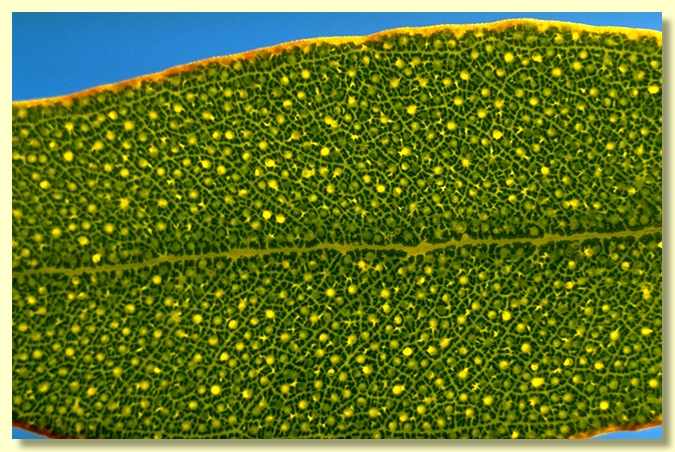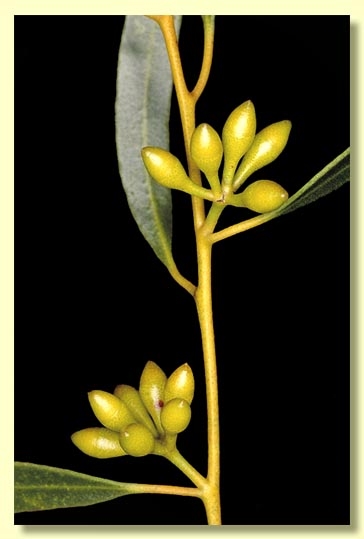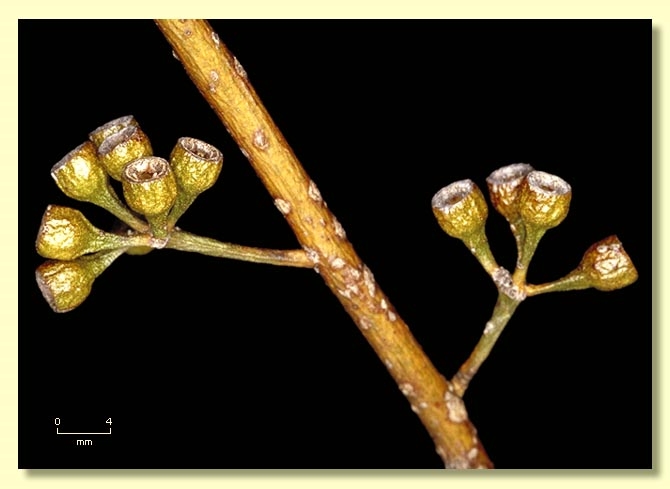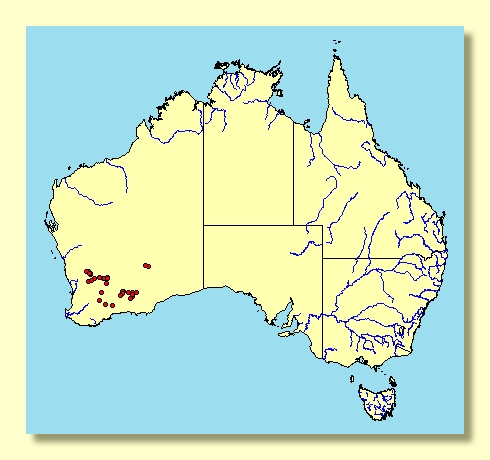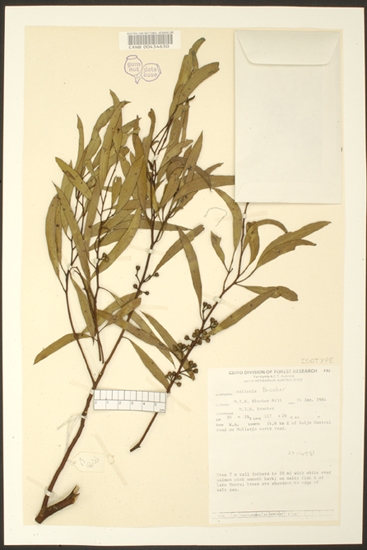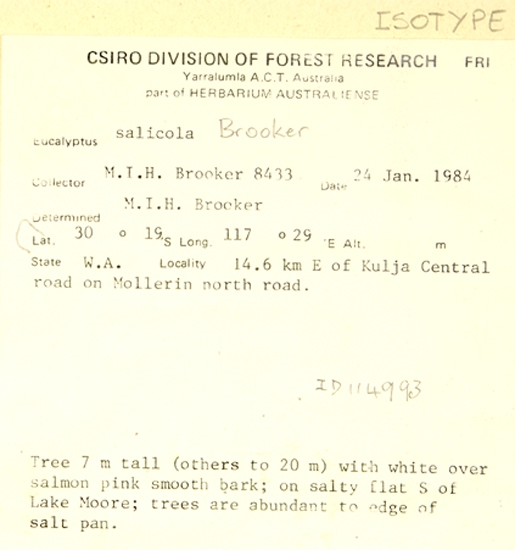Euclid - Online edition
Eucalyptus salicola
Classification
Eucalyptus | Symphyomyrtus | Bisectae | Destitutae | Porantherae | Ovatae
Nomenclature
Description
Tree to 15 m tall. Lignotuber absent; epicormic buds present up stems.
Bark smooth throughout, powdery, white to pale grey over salmon pink.
Branchlets lacking oil glands in the pith.
Juvenile growth (coppice or field seedlings to 50 cm): stems rounded in cross-section, glaucous and very warty; juvenile leaves sessile and opposite becoming sub-opposite, cordate to orbicular, 1–2.7 cm long, 0.7–1.5 cm wide, base usually amplexicaul, sometimes rounded to truncate, margin subcrenulate, apex rounded, glaucous.
Adult leaves alternate, petioles 0.5–1.3 cm long; blade linear to narrowly elliptic-lanceolate, 3.5–10.5 cm long, 0.4–1.2 cm wide, base tapering to petiole, margin entire, apex finely pointed, concolorous, glossy, green, side-veins at an acute or wider angle to midrib, reticulation moderate to dense, intramarginal vein present, oil glands large, intersectional.
Inflorescence axillary unbranched, peduncles rounded to angular, 0.3–1 cm long, buds 7, 9 or 11, pedicellate, pedicels 0.2–0.5 cm long. Mature buds ovoid to fusiform (0.5–0.9 cm long, 0.25–0.4 cm wide), scar present, operculum conical to beaked (0.25–0.5 cm long), stamens inflexed, anthers cuneate-cuboid, adnate to filament apex (rigidly basifixed), dehiscing by sub-terminal pores, a few of the innermost stamens imperfectly formed, style long and straight, stigma blunt to tapered, locules 3(4), the placentae each with 4 vertical rows of ovules. Flowers creamy white.
Fruit pedicellate (pedicels 0.2–0.5 cm long), shortly cupular to hemispherical, 0.2–0.5 cm long, 0.3–0.4(0.5) cm wide, disc pale, descending, valves 3(4), held about rim level.
Seeds brown, 1–2 mm long, flattened-ovoid sometimes pointed at one end, dorsal surface sometimes with longitudinal furrows, smooth, hilum ventral.
Cultivated seedlings (measured at node 10): cotyledons Y-shaped (bisected); stems usually rounded in cross-section, glaucous, very warty; leaves sessile, opposite for ca 20 to 25 nodes then tending to subopposite, cordate to orbicular, 0.8–2.7 cm long, 0.5–2 cm wide, bases amplexicaul to rounded or truncate, discolorous, usually quite glaucous on underside, grey-green to slightly glaucous above, rarely almost non-glaucous and green.
Bark smooth throughout, powdery, white to pale grey over salmon pink.
Branchlets lacking oil glands in the pith.
Juvenile growth (coppice or field seedlings to 50 cm): stems rounded in cross-section, glaucous and very warty; juvenile leaves sessile and opposite becoming sub-opposite, cordate to orbicular, 1–2.7 cm long, 0.7–1.5 cm wide, base usually amplexicaul, sometimes rounded to truncate, margin subcrenulate, apex rounded, glaucous.
Adult leaves alternate, petioles 0.5–1.3 cm long; blade linear to narrowly elliptic-lanceolate, 3.5–10.5 cm long, 0.4–1.2 cm wide, base tapering to petiole, margin entire, apex finely pointed, concolorous, glossy, green, side-veins at an acute or wider angle to midrib, reticulation moderate to dense, intramarginal vein present, oil glands large, intersectional.
Inflorescence axillary unbranched, peduncles rounded to angular, 0.3–1 cm long, buds 7, 9 or 11, pedicellate, pedicels 0.2–0.5 cm long. Mature buds ovoid to fusiform (0.5–0.9 cm long, 0.25–0.4 cm wide), scar present, operculum conical to beaked (0.25–0.5 cm long), stamens inflexed, anthers cuneate-cuboid, adnate to filament apex (rigidly basifixed), dehiscing by sub-terminal pores, a few of the innermost stamens imperfectly formed, style long and straight, stigma blunt to tapered, locules 3(4), the placentae each with 4 vertical rows of ovules. Flowers creamy white.
Fruit pedicellate (pedicels 0.2–0.5 cm long), shortly cupular to hemispherical, 0.2–0.5 cm long, 0.3–0.4(0.5) cm wide, disc pale, descending, valves 3(4), held about rim level.
Seeds brown, 1–2 mm long, flattened-ovoid sometimes pointed at one end, dorsal surface sometimes with longitudinal furrows, smooth, hilum ventral.
Cultivated seedlings (measured at node 10): cotyledons Y-shaped (bisected); stems usually rounded in cross-section, glaucous, very warty; leaves sessile, opposite for ca 20 to 25 nodes then tending to subopposite, cordate to orbicular, 0.8–2.7 cm long, 0.5–2 cm wide, bases amplexicaul to rounded or truncate, discolorous, usually quite glaucous on underside, grey-green to slightly glaucous above, rarely almost non-glaucous and green.
Flowering Time
Flowering has been recorded in January, February and March.
The species may be valuable in the reclamation of salt-affected sites.
Notes
Eucalyptus salicola is a small to medium-sized tree with a smooth and at times powdery trunk, with the general grey and pink appearance of salmon gum (E. salmonophloia). Endemic to Western Australia, it grows on gypseous sands and loams near salt lakes in the wheatbelt east from Lake Moore in the north and Lake Buchan in the south through the goldfields to the fringes of the Great Victoria Desert (near Lake Rason and Lake Minigwal).
Eucalyptus salicola belongs in Eucalyptus subgenus Symphyomyrtus section Bisectae subsection Destitutae because the buds have two opercula, cotyledons are Y-shaped and branchlets lack oil glands in the pith. Within this subsection E. salicola belongs to a group of about 16 species, series Porantherae, that are further characterised by having anthers completely adnate to the staminal filaments, strongly inflexed stamens, densely reticulate leaves with intersectional oil glands and by the fruit with a distinct thick rim that includes a whitish descending disc.
Eucalyptus salicola is closely related to E. horistes because of the round, glaucous juvenile leaves, but the latter species is a mallee, usually with some rough basal bark and is not associated with salt lakes. E. salicola is a remarkable tree for such an inhospitable habitat, being well adapted to unreliable low rainfall, high summer temperatures, cold winter nights and saline soils. E. salicola looks very much like salmon gum, which belongs to another taxonomic series and differs in the non-saline habitat, larger ovate to lanceolate petiolate juvenile leaves, globoid buds and stamens with versatile anthers.
Eucalyptus salicola belongs in Eucalyptus subgenus Symphyomyrtus section Bisectae subsection Destitutae because the buds have two opercula, cotyledons are Y-shaped and branchlets lack oil glands in the pith. Within this subsection E. salicola belongs to a group of about 16 species, series Porantherae, that are further characterised by having anthers completely adnate to the staminal filaments, strongly inflexed stamens, densely reticulate leaves with intersectional oil glands and by the fruit with a distinct thick rim that includes a whitish descending disc.
Eucalyptus salicola is closely related to E. horistes because of the round, glaucous juvenile leaves, but the latter species is a mallee, usually with some rough basal bark and is not associated with salt lakes. E. salicola is a remarkable tree for such an inhospitable habitat, being well adapted to unreliable low rainfall, high summer temperatures, cold winter nights and saline soils. E. salicola looks very much like salmon gum, which belongs to another taxonomic series and differs in the non-saline habitat, larger ovate to lanceolate petiolate juvenile leaves, globoid buds and stamens with versatile anthers.
Origin of Name
Eucalyptus salicola: Latin sali-, salt and -cola, dweller.
Copyright © CANBR 2020, all rights reserved.

Web edition hosted at https://apps.lucidcentral.org/euclid

